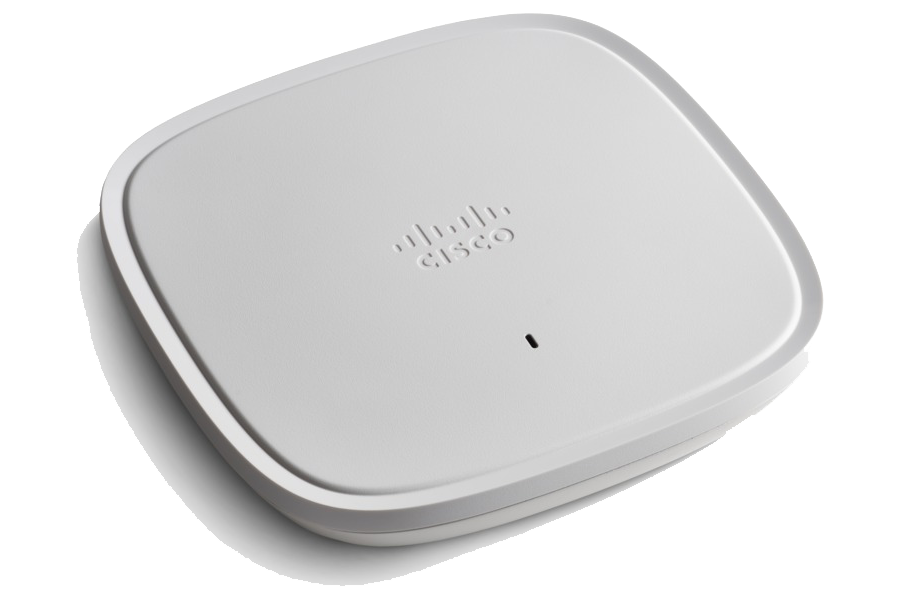
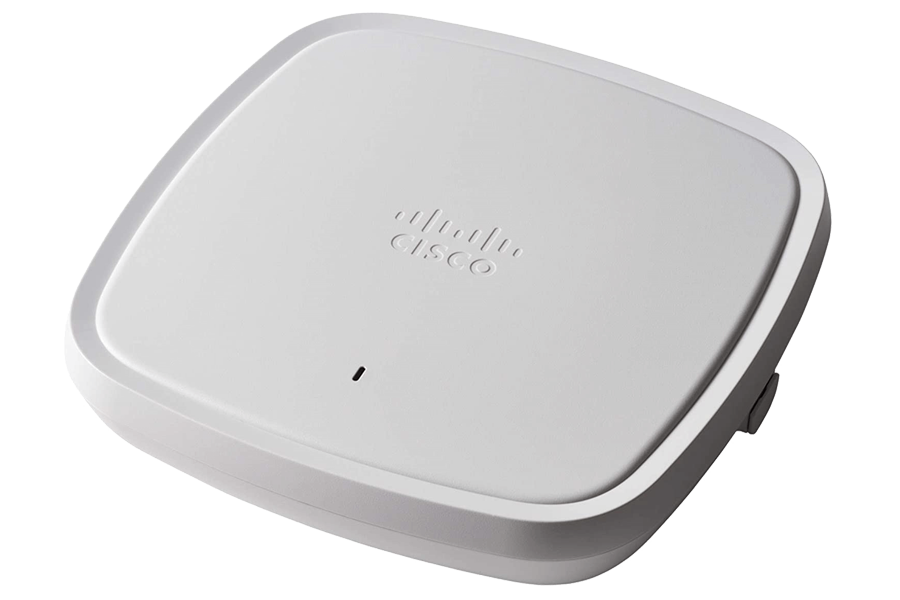
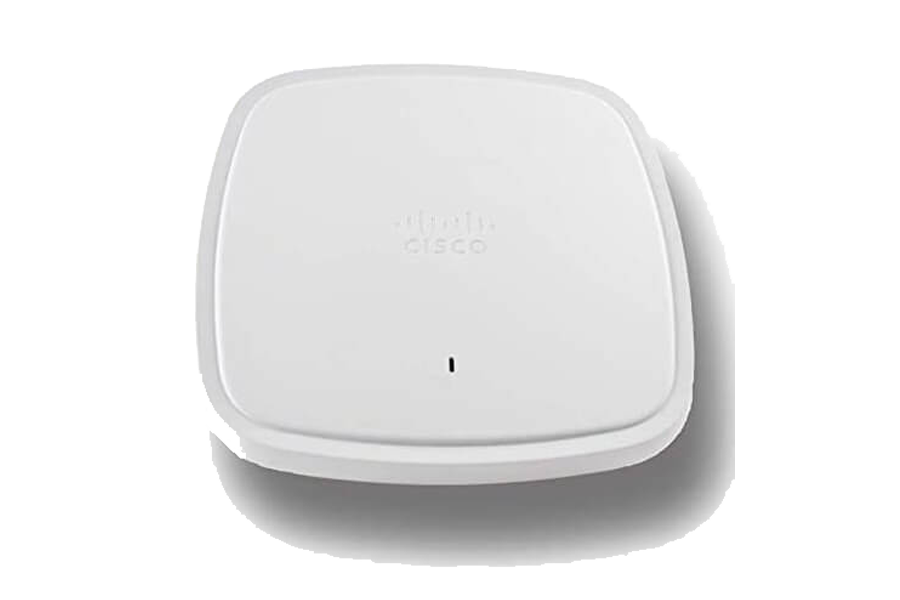
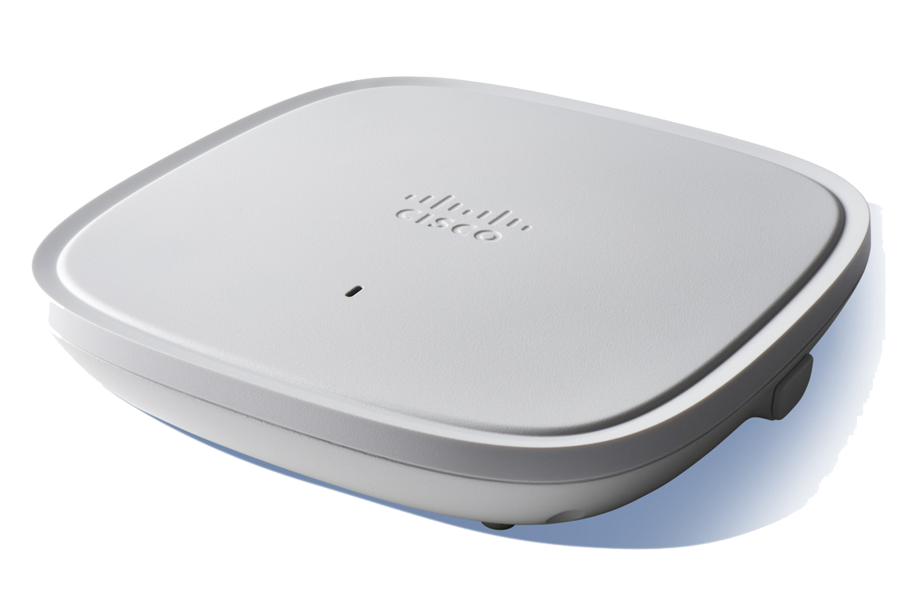
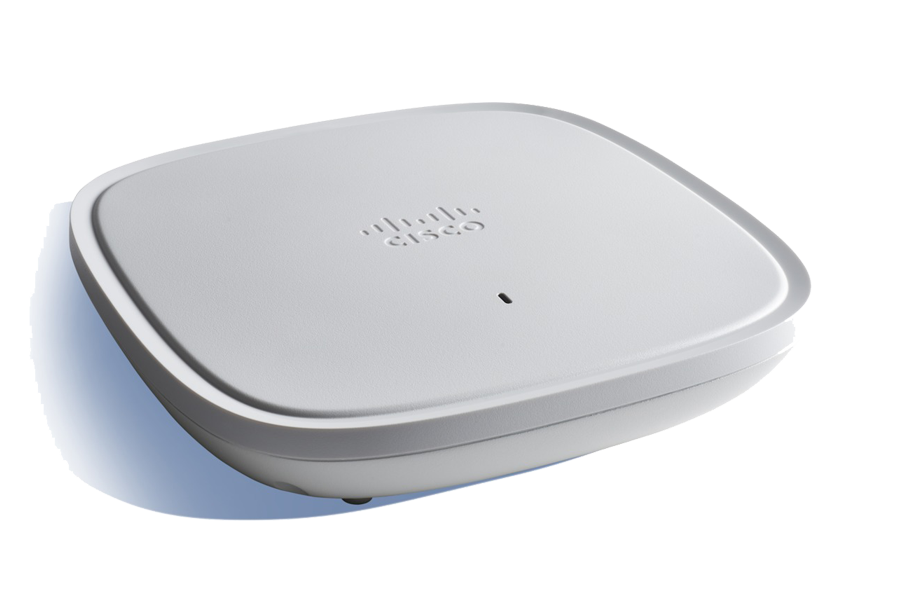
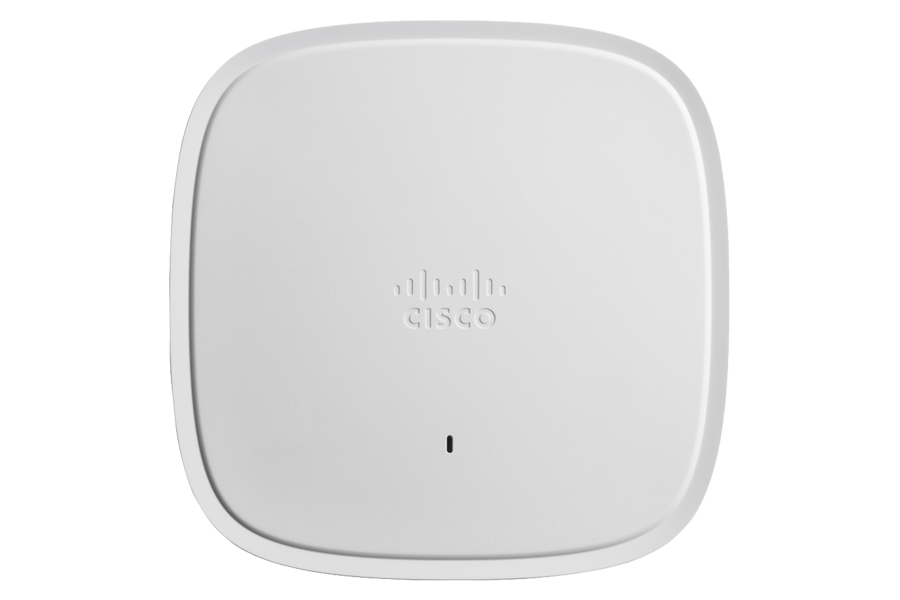
Cisco Catalyst 9120AX Series Access Points - C9120AXI-D
Cisco Catalyst 9120AX Series
Description
The Cisco® Catalyst® 9120AX Series Access Points are the next generation of enterprise access points. They are resilient, secure, and intelligent.
We are more dependent on our wireless networks than ever before. Additional devices connect to the network every year, and the Cisco Catalyst 9120AX Series Access Points will provide a seamless experience anywhere for everyone. Going beyond the Wi-Fi 6 (802.11ax) standard, the 9120AX Series provides integrated security, resiliency, and operational flexibility as well as increased network intelligence.
Extending Cisco’s intent-based network and perfect for networks of all sizes, the Cisco Catalyst 9120AX Series scales to the growing demands of IoT while fully supporting the latest innovations and new technologies. Not only that, but the 9120AX Series is a leader in performance, security, and analytics.
The Cisco Catalyst 9120AX Series Access Points, paired with Cisco DNA, are enterprise-class products that will address your current and future needs. These access points are the first step in updating your network so that you can take better advantage of all of the features and benefits that Wi-Fi 6 provides.
Features and benefits
Wi-Fi 6 (802.11ax)
The IEEE 802.11ax emerging standard, also known as High-Efficiency-Wireless (HEW) or Wi-Fi 6, builds on 802.11ac. It delivers a better experience in typical environments with more predictable performance for advanced applications such as 4K or 8K video, high-density, high-definition collaboration apps, all-wireless offices, and IoT. Wi-Fi 6 is designed to use both the 2.4-GHz and 5-GHz bands, unlike the 802.11ac standard.
Cisco RF ASIC
Cisco RF ASIC is a fully integrated Software-Defined Radio (SDR) that can perform advanced RF spectrum analysis and delivers features like Cisco CleanAir®, Wireless Intrusion Prevention System (wIPS), Fast Locate*, and DFS detection. (*Future)
Uplink/downlink OFDMA
Orthogonal Frequency-Division Multiple Access (OFDMA)-based scheduling splits the bandwidth into smaller chunks called Resource Units (RUs), which can be allocated to individual clients in both the downlink and uplink directions to reduce overhead and latency.
MU?MIMO technology
Supporting four spatial streams, Multiuser Multiple Input, Multiple Output (MU-MIMO) enables access points to split spatial streams between client devices, to maximize throughput.
BSS coloring
Spatial reuse (also known as Basic Service Set [BSS] coloring) allows the access points and their clients to differentiate between BSSs, thus permitting more simultaneous transmissions.
Target wake time
A new power savings mode called Target Wake Time (TWT) allows the client to stay asleep and to wake up only at prescheduled (target) times to exchange data with the access point. This offers significant energy savings for battery-operated devices, up to three to four times greater compared to 802.11n and 802.11ac.
Intelligent Capture
Intelligent Capture probes the network and provides Cisco DNA Center with deep analysis. The software can track over 240 anomalies and instantaneously review all packets on demand, emulating the onsite network administrator. Intelligent Capture allows for more informed decisions on your wireless networks.
Flexible Radio Assignment
Allows the access points to intelligently determine the operating mode of serving radios based on the RF environment. The access points can operate in the following modes:
- 2.4-GHz and 5-GHz mode: One radio will serve clients in 2.4-GHz mode, while the other serves clients in 5-GHz mode.
- Dual 5-GHz mode: Both radios inside the access point operate on the 5-GHz band, maximizing the benefits of Wi-Fi 6 and increasing client device capacity.
Dual 5-GHz radio support
Enables both radios to operate in 5-GHz client serving mode, allowing an industry-leading 5.2 Gbps (2 x 2.6 Gbps) over-the-air speeds while increasing client capacity.
Smart antenna connector
An intelligent second physical antenna connector is included on 9120AX Series access points with an external antenna. This connector provides advanced network design flexibility for high-density and large open-area environments such as auditoriums, convention centers, libraries, cafeterias, and arenas/stadiums, allowing two sets of antennas to be connected and active on a single access point.
Cisco Embedded Wireless Controller
The 9120AX Series Wi-Fi 6 access points is available with a built-in controller. The Cisco Embedded Wireless Controller on Catalyst 9100 Access Points provides an easy-to-deploy and manage option that does not require a physical appliance. The control resides on the access point so there is no added footprint or complexity. And, because it uses Cisco Catalyst 9800 Series code, it’s easy to migrate your network as your needs grow. For more details refer to the EWC data sheet.
Application Hosting on Catalyst 9100 Access
Application Hosting on Catalyst 9100 Access Points helps future-proof and simplify IoT deployments by eliminating the need to install and manage overlay networks. Utilizing the USB interface, containerized applications and hardware modules can be deployed to reduce cost and complexity. Adding Cisco DNA Center provides workflows and deployment-wide application lifecycle management.
Multigigabit Ethernet support
Provides uplink speeds of 2.5 Gbps, in addition to 100 Mbps and 1 Gbps. All speeds are supported on Category 5e cabling for an industry first, as well as 10GBASE-T (IEEE 802.3bz) cabling.
Bluetooth® radio
Integrated Bluetooth Low Energy 5 radio to enable IoT use cases such as location tracking and wayfinding.
Container support for applications
Enables edge computing capabilities for IoT applications on the host access point.
Apple features
Apple and Cisco have partnered to create an optimal mobile experience for iOS devices on corporate networks based on Cisco technologies. Using new features in iOS 10, in combination with the latest software and hardware from Cisco, businesses can now more effectively use their network infrastructure to deliver an enhanced user experience across all business applications.
At the center of the collaboration is a unique handshake between the Cisco WLAN and Apple devices. This handshake enables the Cisco WLAN to provide an optimal Wi-Fi roaming experience to Apple devices. Additionally, the Cisco WLAN trusts Apple devices and gives priority treatment for business-critical applications specified by the Apple device. This feature is also known as Fast Lane.
Secure infrastructure
Trustworthy systems built with Cisco Trust Anchor Technologies provide a highly secure foundation for Cisco products. With the Cisco Catalyst 9100 Access Points, these technologies enable hardware and software authenticity assurance for supply chain trust and strong mitigation against man-in-the-middle attacks that compromise software and firmware. Trust Anchor capabilities include:
- Image signing
- Secure Boot
- Cisco Trust Anchor module
Cisco DNA support
Pairing the Cisco Catalyst 9120AX Series Access Points with Cisco DNA allows for a total network transformation. Cisco DNA allows you to truly understand your network with real-time analytics, quickly detect and contain security threats, and easily provide networkwide consistency through automation and virtualization. The 9120AX Series supports Software-Defined Access (SD-Access), Cisco’s leading enterprise architecture.
Working together, the Cisco Catalyst 9120AX Series and Cisco DNA offer such features as:
- Cisco DNA Spaces
- Cisco Identity Services Engine
- Cisco DNA Analytics and Assurance
The result? Your network stays relevant, becomes digital ready, and is the lifeblood of your organization.
Note: For information about Cisco DNA, refer to the Cisco DNA Solution Overview.
Product specifications
- Software
- Cisco Unified Wireless Network Software Release 8.9.x or later
- Cisco IOS ® XE Software Release 16.11 with AP Device Pack, or later
- Supported wireless LAN controllers
- Cisco Catalyst 9800 Series Wireless Controllers
- Cisco 3500, 5520, and 8540 Series Wireless Controllers and Cisco Virtual Wireless Controller
- 802.11n version 2.0 (and related) capabilities
- 4x4 MIMO with four spatial streams
- Maximal Ratio Combining (MRC)
- 802.11n and 802.11a/g beamforming
- 20- and 40-MHz channels
- PHY data rates up to 890 Mbps (40 MHz with 5 GHz and 20 MHz with 2.4 GHz)
- Packet aggregation: A-MPDU (transmit and receive), A-MSDU (transmit and receive)
- 802.11 Dynamic Frequency Selection (DFS)
- Cyclic Shift Diversity (CSD) support
- 802.11ac
- 4x4 downlink MU-MIMO with four spatial streams
- MRC
- 802.11ac beamforming
- 20-, 40-, 80-, and 160-MHz channels
- PHY data rates up to 3.47 Gbps (160 MHz with 5 GHz)
- Packet aggregation: A-MPDU (transmit and receive), A-MSDU (transmit and receive)
- 802.11 DFS
- CSD support
- 802.11ax
- 4x4 downlink MU-MIMO with four spatial streams
- Uplink/downlink OFDMA
- TWT
- BSS coloring
- MRC
- 802.11ax beamforming
- 20-, 40-, 80-, and 160-MHz channels
- PHY data rates up to 5.38 Gbps (160 MHz with 5 GHz and 20 MHz with 2.4 GHz)
- Packet aggregation: A-MPDU (transmit and receive), A-MSDU (transmit and receive)
- 802.11 DFS
- CSD support
- Integrated antenna
- Flexible radio (either on 2.4 GHz or on 5 GHz)
- 2.4 GHz, peak gain 4 dBi, internal antenna, omnidirectional in azimuth
- 5 GHz, peak gain 5 dBi, internal antenna, omnidirectional in azimuth
- Dedicated 5-GHz radio
- 5 GHz, peak gain 5 dBi, internal antenna, omnidirectional in azimuth
- External antenna (sold separately)
- Cisco Catalyst 9120AXE Access Points are certified for use with antenna gains up to 6 dBi (2.4 GHz and 5 GHz)
- Cisco Catalyst 9120AXP Access Points) are certified for use with antenna gains up to 13 dBi (2.4 GHz and 5 GHz) with the AIR-ANT2513P4M-N= antenna
- Cisco offers the industry's broadest selection of antennas, delivering optimal coverage for a variety of deployment scenarios
- Supports Self-Identifiable Antennas (SIA) on one RP-TNC port
- For more details, see the Catalyst 9120AX Series Deployment Guide.
- Smart antenna connector
- Available on the 9120AXE and 9120AXP only
- Compact multi-RF connector with DART interface
- Requires the AIR-CAB002-DART-R= 2 ft smart antenna connector when used with antennas with RP-TNC connector
- Required when running the flexible radio as either a second 5-GHz serving radio or a Wireless Security Monitoring radio
- Interfaces
- 1x 100, 1000, 2500 Multigigabit Ethernet (RJ-45) – IEEE 802.3bz
- o Auto-MDIX support
- Management console port (RJ-45)
- USB 2.0 @ 4.5W
- Indicators
- Status LED indicates boot loader status, association status, operating status, boot loader warnings, and boot loader errors
- Dimensions (W x L x H) : 8.5 x 8.5 x 1.7” (21.6 x 21.6 x 4.3 cm)
- Weight : 2.87 lb (1.3 kg)
- Input power requirements
- 802.3at Power over Ethernet Plus (PoE+), 802.3bt Cisco Universal PoE (Cisco UPOE+, Cisco UPOE ®)
- 802.3af PoE
- Cisco power injector, AIR-PWRINJ6= (Note: This injector supports only 802.3at)
- Cisco power injector, AIR-PWRINJ5= (Note: This injector supports only 802.3af)
- Environmental
- Nonoperating (storage) temperature: -22° to 158°F (-30° to 70°C)
- Nonoperating (storage) altitude test: 25?C, 15,000 ft.
- Operating temperature: 32° to 122°F (0° to 50°C)
- Operating humidity: 10% to 90% (noncondensing)
- Operating altitude test: 40?C, 9843 ft.
- Note: When the ambient operating temperature exceeds 40°C, the access point will shift from 4x4 to 2x2 on both the 2.4-GHz and 5-GHz radios, uplink Ethernet will downgrade to 1 Gigabit Ethernet; however, the USB interface will remain enabled
- System memory
- 2048 MB DRAM
- 1024 MB flash
- Warranty : Limited lifetime hardware warranty
- Available transmit power settings
- 2.4 GHz
- 23 dBm (200 mW)
- -4dBm(0.39mW)
- 5 GHz
- 23 dBm (200 mW)
- -4dBm (0.39mW)
- 2.4 GHz
- Regulatory domains
- Note: Customers are responsible for verifying approval for use in their individual countries. To verify approval and to identify the regulatory domain that corresponds to a particular country, visit https://www.cisco.com/go/aironet/compliance
- For information about regulatory domain support, refer to the Cisco Regulatory Domain White Paper.
- Compliance standards
- Safety:
- IEC 60950-1
- EN 60950-1
- UL 60950-1
- CAN/CSA-C22.2 No. 60950-1
- AS/NZS 60950-1
- UL 2043
- Class III equipment
- Emissions:
- CISPR 32 (rev. 2015)
- EN 55032 (rev. 2012/AC:2013)
- EN 55032 (rev. 2015)
- EN 55035 2010
- EN61000-3-2 (rev. 2014)
- EN61000-3-3 (rev. 2013)
- KN61000-3-2
- KN61000-3-3
- AS/NZS CISPR 32 Class B (rev. 2015)
- 47 CFR FCC Part 15B
- ICES-003 (rev. 2016 Issue 6, Class B)
- VCCI-CISPR 32:2016
- VCCI (V3)
- CNS (rev. 13438)
- KN-32
- KN-35
- KN 301 489-17
- TCVN 7189 (rev. 2009)
- Immunity:
- CISPR 24 (rev. 2010)
- EN 55024 / EN 55035 (rev. 2010)
- Emissions and immunity:
- EN 301 489-1 (v2.1.1 2017-02)
- EN 301 489-17 (v3.1.1 2017-02)
- QCVN (18:2014)
- KN 489-1
- KN 489-17
- EN 60601 (1-1:2015)
- Radio:
- EN 300 328 (v2.1.1)
- EN 301 893 (v2.1.1)
- AS/NZS 4268 (rev. 2017)
- 47 CFR FCC Part 15C, 15.247, 15.407
- RSP-100
- RSS-GEN
- RSS-247
- China regulations SRRC
- LP0002 (rev 2018.1.10)
- Japan Std. 33a, Std. 66, and Std. 71
- RF safety:
- EN 50385 (rev. Aug 2002)
- ARPANSA
- AS/NZS 2772 (rev. 2016)
- EN 62209-1 (rev. 2016)
- EN 62209-2 (rev. 2010)
- 47 CFR Part 1.1310 and 2.1091
- RSS-102
- IEEE standards:
- IEEE 802.3
- IEEE 802.3ab
- IEEE 802.3af/at
- IEEE 802.11 a/b/g/n/ac/ax
- IEEE 802.11h, 802.11d
- Security:
- 802.11i, Wi-Fi Protected Access 3 (WPA3), WPA2, WPA
- 802.1X
- Advanced Encryption Standard (AES)
- Extensible Authentication Protocol (EAP) types:
- EAP-Transport Layer Security (TLS)
- EAP-Tunneled TLS (TTLS) or Microsoft Challenge Handshake Authentication Protocol Version 2 (MSCHAPv2)
- Protected EAP (PEAP) v0 or EAP-MSCHAPv2
- EAP-Flexible Authentication via Secure Tunneling (EAP-FAST)
- PEAP v1 or EAP-Generic Token Card (GTC)
- EAP-Subscriber Identity Module (SIM)
- Safety:
